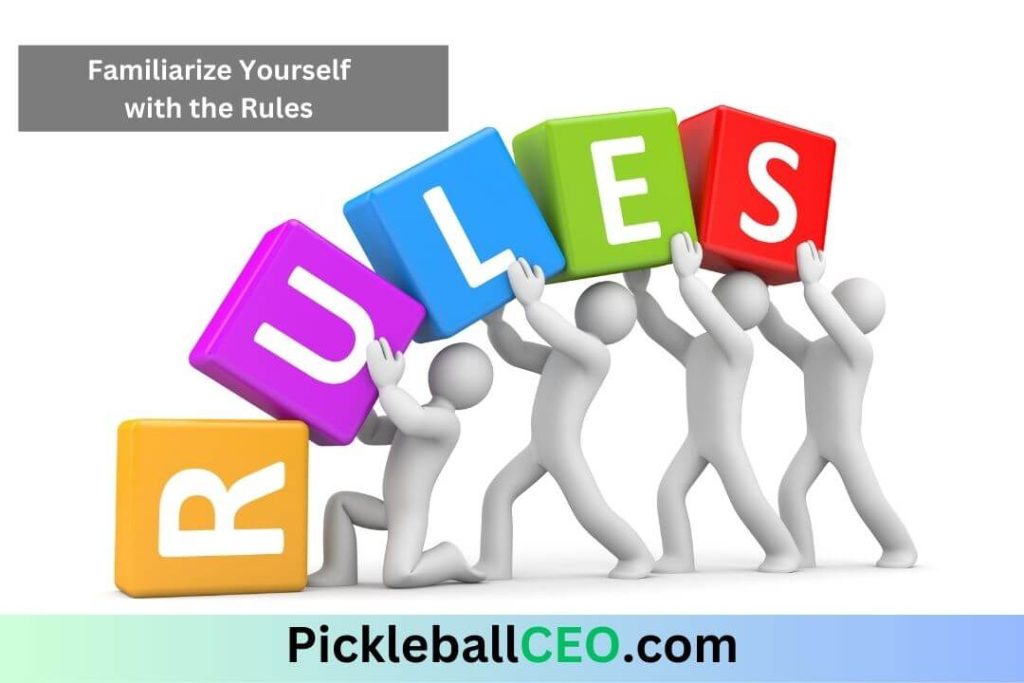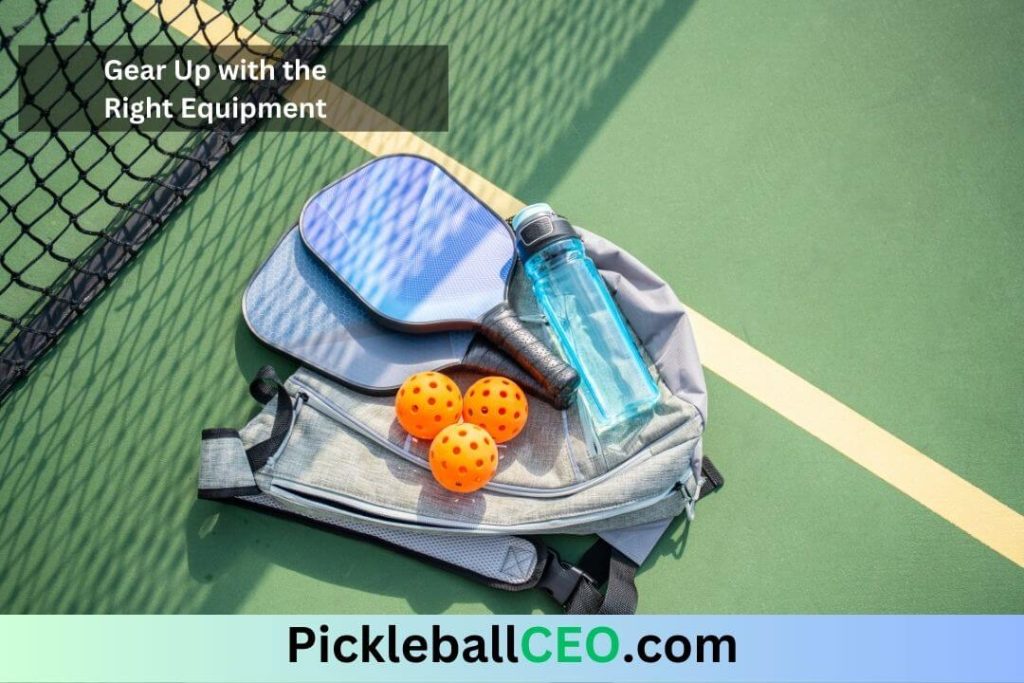Introduction And Tips To Start Playing Pickleball
Playing Pickleball, is a fun and engaging sport suitable for all ages and skill levels, has been gaining popularity worldwide. Whether you’re a beginner looking to get started or interested in trying out a new sport, these five easy tips will help you kick-start your pickleball journey and get you playing in no time.
1. Familiarize Yourself with the Rules


Before diving into pickleball, it’s essential to familiarize yourself with the rules of the game. Understanding the basic rules will ensure fair play and a smooth experience on the court. Here’s what you need to know:
Court Dimensions and Layout
Pickleball is typically played on a badminton-sized court, measuring 20 feet wide and 44 feet long for doubles play. The court is divided into two equal halves by a net, with a non-volley zone (kitchen) located on each side of the net.
Scoring System
Pickleball uses a rally scoring system, meaning points can be scored by the serving or receiving team. A point is awarded for every rally won, and games are typically played to 11 or 15 points. However, specific rules may vary depending on the level of play or tournament format.
Serve and Serve Sequence
The serve is always performed underhand, and the serving team must hit the ball diagonally across the net into the opponent’s court. The server must keep at least one foot behind the baseline until the ball is struck. Both teams continue to serve until a fault occurs, resulting in a side out or a point awarded to the opposing team.
Non-Volley Zone (Kitchen)
The non-volley zone, commonly known as the kitchen, is a seven-foot area on both sides of the net. Players are not allowed to volley the ball (hit it in the air without letting it bounce) while standing in the kitchen. Volleys can only be made once the ball has bounced or outside the kitchen area.
Faults and Let Serves
Various scenarios can result in faults, such as serving into the net, hitting the ball out of bounds, stepping into the non-volley zone, or volleying before the ball has bounced. Additionally, let serves occur when the serve hits the net but still lands within the proper serving area. Let serves are typically replayed without penalty. Understanding these fundamental rules will help you get started on the right foot and enjoy the game of pickleball with confidence.
2. Gear Up with the Right Equipment


To get started with pickleball, you’ll need some essential equipment. Consider the following:
Pickleball Paddles
Pickleball paddles are a crucial piece of equipment. They come in various materials such as wood, composite, or graphite, each offering different characteristics in terms of weight, power, and control. Beginners often find composite paddles to be a good balance of affordability and performance. Try different paddle weights and grip sizes to find the one that feels comfortable and suits your playing style.
Pickleballs
Pickleballs are unique to the sport and have specific characteristics that affect gameplay. These plastic balls have small holes, which provide stability and allow for a controlled flight path. Opt for indoor or outdoor balls depending on where you plan to play. Indoor balls are usually softer and have larger holes, while outdoor balls are more durable and designed for outdoor conditions.
Footwear and Attire
Invest in a pair of athletic shoes that provide stability, cushioning, and good traction. Look for shoes designed for court sports to ensure proper support and reduce the risk of injuries. Comfortable, moisture-wicking clothing that allows for ease of movement is also recommended. Consider wearing a hat and applying sunscreen to protect yourself from the sun during outdoor play. By equipping yourself with the right gear, you’ll have the necessary tools to enjoy pickleball and perform optimally on the court.
3. Find a Suitable Pickleball Court
Locating a suitable pickleball court is essential to begin playing. Here are some tips to find a court near you:
Local Parks and Recreation Centers
Many local parks and recreation centers have dedicated pickleball courts or convert existing tennis or basketball courts for pickleball play. Check with your local parks and recreation department to find out if there are any pickleball courts available for public use. Some facilities may require reservations or have designated times for pickleball play.
Community Centers and Clubs
Community centers, sports clubs, or retirement communities often offer pickleball facilities and organized play sessions. Joining these centers or clubs can provide opportunities to connect with other players, participate in leagues or tournaments, and access coaching or training programs tailored for beginners.
Online Resources and Pickleball Associations
Various online resources and pickleball associations provide directories of pickleball courts worldwide. Websites and mobile apps dedicated to pickleball can help you find nearby courts, read reviews, and even connect with other players in your area. Explore online communities and forums where pickleball enthusiasts share information, arrange meetups, and offer advice for beginners.
By finding a suitable pickleball court, you’ll have a designated space to practice, play, and connect with other pickleball enthusiasts in your community.
4. Start with Basic Shots and Fundamentals
To build a solid foundation in pickleball, it’s important to focus on the basic shots and fundamental techniques. Here’s what you should keep in mind:
The Serve
The serve is the starting shot in pickleball and sets the tone for the point. Practice different serve techniques, such as the underhand serve or the more advanced spin serves, to find what works best for you. Focus on consistency and placing the serve in the desired location on the opposite court.
Groundstrokes
Develop your forehand and backhand groundstrokes to have reliable shots from the baseline. Work on generating power and control through proper grip, body rotation, and follow-through. Practice hitting groundstrokes to different areas of the court, aiming for consistency and accuracy.
Volleys
Mastering volleys is essential to take advantage of the fast-paced nature of pickleball. Practice your volleys by hitting the ball before it bounces, focusing on soft hands, controlled paddle angles, and good footwork. Work on your reaction time and maintaining a stable position at the non-volley zone (kitchen) to dominate the net game.
Dinks
Dinking is a short, controlled shot performed close to the net. It requires touch, finesse, and precision. Practice the soft, gentle dink shots that arc over the net and land in the kitchen. Develop the ability to maintain a consistent rhythm and control the pace of the game with well-executed dinks. By honing these basic shots and mastering the fundamental techniques, you’ll gain confidence, consistency, and control on the pickleball court.
5. Play with Others and Have Fun
Playing with others is a fantastic way to enhance your pickleball skills and enjoy the social aspect of the sport. Here’s why it’s important and how to make the most of your pickleball experience:
Join Pickleball Communities and Clubs
Look for local pickleball communities, clubs, or leagues in your area. These groups often organize regular play sessions, social events, and tournaments. Joining these communities will provide opportunities to meet other players, improve your skills, and build friendships with fellow pickleball enthusiasts.
Participate in Beginner-Friendly Clinics and Workshops
Many pickleball communities and clubs offer clinics and workshops specifically tailored for beginners. These sessions provide instruction from experienced players or coaches who can guide you through the basics, offer tips for improvement, and answer any questions you may have. Taking part in these clinics will help you gain confidence and accelerate your learning curve.
Embrace the Learning Process
Pickleball, like any sport, has a learning curve. Embrace the process and be patient with yourself as you develop your skills. Every player starts as a beginner, and with practice and persistence, you’ll see improvements over time. Don’t be afraid to make mistakes or ask for advice from more experienced players. Learning from both successes and setbacks will contribute to your growth as a pickleball player.
Play with a Variety of Skill Levels
Playing with a variety of skill levels can be beneficial to your development. Challenging yourself against more skilled players can push you to elevate your game and learn new strategies. On the other hand, playing with beginners allows you to practice and refine your skills while helping others improve. Embrace the opportunity to play with players of all levels, as it will contribute to your overall progress and enjoyment of the game.
Have Fun and Enjoy the Game
Above all, remember to have fun while playing pickleball. Enjoy the friendly competition, the thrill of hitting great shots, and the camaraderie with your fellow players. Pickleball is not only about improving your skills but also about creating positive experiences and lasting memories. Celebrate your successes, laugh at the occasional mishaps, and cherish the joy that comes with being part of the pickleball community.
By playing with others, immersing yourself in the pickleball community, and maintaining a positive and fun-loving attitude, you’ll not only enhance your skills but also forge lasting connections and create a fulfilling pickleball experience. So, get out on the court, join in the fun, and embrace the exciting journey of pickleball!
Conclusion
Congratulations on taking the first step towards playing pickleball! By following these five easy tips, you’ll be well-equipped to start your pickleball journey with confidence. Familiarize yourself with the rules, gear up with the right equipment, find a suitable court, master the basic shots and fundamentals, and most importantly, play with others and have fun. Remember that pickleball is not just about improving your skills but also about building connections and creating enjoyable experiences. So, grab your paddle, find a court, and embark on an exciting adventure in the world of pickleball!






